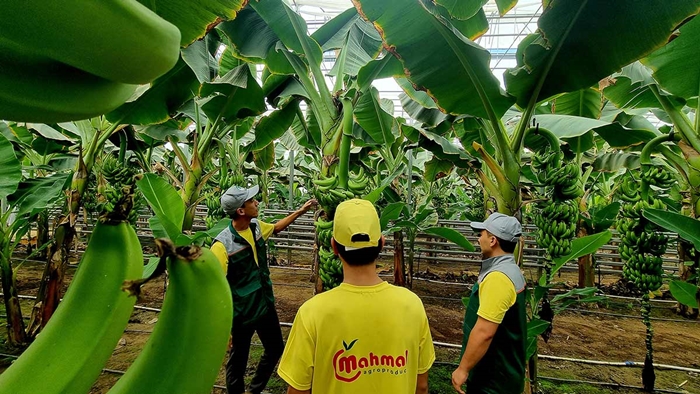Could Turkmenistan become the next banana exporter? Businessman Dovletgeldy Ballyyev explores this intriguing possibility in his article for “Biznes Reklama,” outlining favorable climate conditions, existing agricultural expertise, and strategic logistics advantages that could propel Turkmenistan into the lucrative banana export market.
Turkmenistan has become one of the region’s leading exporter of vegetables and fruits grown in greenhouses. In particular, the country is considered the leader of Central Asia in the production and export of greenhouse tomatoes.
“The next main tasks facing Turkmen businessmen engaged in the greenhouse business is to diversify the types of fruit and vegetable products supplied to foreign markets, as well as the geography of their exports,” the author believes.
Currently, the main banana producers in Turkmenistan are:
- “Ferhar” – has a greenhouse with an area of 1 hectare in the Sakarchaga district of the Mary province
- “Hemsaya“ in the Kaka district of the Akhal province – has a greenhouse with an area of 5 hectares.
- In 2024, Hemsaya will launch another 10 hectares of greenhouses for banana production.
Banana greenhouses are usually built at a height of 7.8 to 9.6 meters. About 1,800-2,000 bananas can be grown on one hectare of the greenhouse. Bananas grow well at temperatures from +20 to +30 degrees. They are heat-resistant, but in a climate with temperatures reaching +40 – +45 degrees Celsius, it is necessary to maintain humidity at least 40 percent.
As for picking bananas, it is recommended to collect them before ripening. Bananas undergo a special ripening process in dedicated chambers infused with ethylene gas for 5-6 days. Unripe bananas can be exported to any country within 50-55 days.
Turkmen entrepreneurs prefer to grow bananas of the “Grande Naine” variety.
“Due to the increase in the consumer capacity of the population of Central Asian countries, the demand for bananas is also growing. Meanwhile, the banana trade is also growing in Turkmenistan. Referring to statistics, banana imports into the country amounted to 11,365.6 tons – in 2017; 11,298.5 tons – in 2018; 9,788.4 tons – in 2019; 9,050 tons – in 2020, 2 tons; 6,536 tons – in 2021; 11,482.1 tons – in 2022; and 10,064.1 tons – in 2023,” Ballyyev writes.
Thus, on average, Turkmenistan buys 10,000 tons of bananas annually.
With the launching domestic banana production, the price of fruit in the internal market will decrease, and even taking into account by-production (for example, the use of bananas in various food products), the banana consumption in the country may raise to 15,000 tons. With this in mind, crops grown in greenhouses with an area of 115-120 hectares can meet domestic demand.
“In addition, by developing banana production, we have a number of advantages to become the main supplier of this fruit to neighboring Uzbekistan, the southern and western regions of Kazakhstan, neighboring regions of Iran, Kyrgyzstan and Afghanistan. We can also export bananas to Azerbaijan and Russia through the Caspian Sea, using the capabilities of the Turkmenbashi International Seaport. Our proximity to these markets reduces transportation costs. As a result, the market price of the product becomes cheaper,” the Turkmen businessman notes.
In 2022, a record volume of bananas was imported to the Uzbekistan’s market from abroad – more than 140 thousand tons of bananas, of which 138 thousand tons were supplied from Ecuador. “Demand for bananas is also high in the markets of Kazakhstan and Iran. Given this, there is a great opportunity to build greenhouses in Turkmenistan for growing bananas on an area of 1500-2000 hectares and sell the harvest on foreign markets,” the author writes.
Turkmenistan has promising opportunities in banana cultivation, Ballyyev argues, proving this by following facts:
- The country’s hot climate is suitable for banana cultivation
- Conducive legal conditions for landowners and agricultural entrepreneurs
- Banana business is less labor- and capital-intensive compared to greenhouse cultivation of tomatoes and other crops.
- Banana is more resistant to diseases than other greenhouse crops.
- The geographical proximity of Turkmenistan facilitates the supply of products to the markets of Uzbekistan, Kazakhstan, Kyrgyzstan, Afghanistan and Iran. Shipping bananas from overseas to these countries takes an average of 30-40 days, and also requires high transportation costs.
- In the main banana producing or exporting countries, fruits are grown in open fields, and with low yields due to adverse weather conditions, this leads to an increase in prices worldwide.
- In Turkmenistan, since bananas are grown in greenhouses, such a risk can be avoided, and even in the case of soaring prices, it will be possible to maintain price stability in the domestic market.
In general, the increase in banana greenhouses in the country will serve to ensure food abundance in the domestic market, expand the volume of import-substituting production, create new jobs, increase the country’s economic potential and export opportunities, the entrepreneur summarizes.
According to Dovletgeldy Ballyyev, for Turkmen greenhouse owners seeking to diversify their ventures, bananas offer a lucrative opportunity, promising high yields and efficient water usage.///nCa, 8 January 2024

